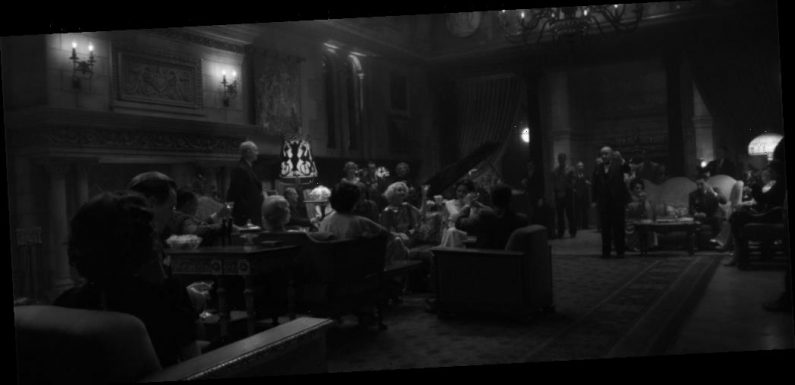
One of the major craft achievements of “Mank” was how David Fincher’s visual effects team meticulously recreated ’30s-era LA in black-and-white. (They used the matte paintings of Artemple, Territory’s LED screens, and Savage’s sky replacement with Unreal’s game engine.) The work has been shortlisted for the VFX Oscar and garnered a VES nomination for supporting visual effects.
“Most of the effects were what we call our ‘body and fender’ work, where [David] shot something and it’s not quite right and it needed to be replaced,” said visual effects producer Peter Mavromates. “For example, during the Louis B. Mayer birthday party at San Simeon, he didn’t want to deal with real fire in the fireplace, so those are all added [in CG] afterwards. He’s all about efficiency on set.”
Also added were the cloudy skies during the shooting of an elaborate home movie with Marion Davies (Amanda Seyfried) tied to a stake. “Sky replacement of shots were for consistency using the Unreal game engine with 3D model placement,” Mavromates added.
Ever since “Zodiac,” Fincher has acted as his own visual effects supervisor, concerning himself with the design and planning of shot integration. “Most discussions had to do with the look of the movie and being committed to black-and-white, so we did a lot of camera tests before shooting [with cinematographer Eric Messerschmidt],” Mavromates said. And, as a result of the black-and-white look, the VFX work entailed shot replacement through rotoscoping rather than the use of blue or green screen, which didn’t match the luminosity.
“Mank”
Netflix
Although there were LED screens utilized by Territory for traveling car shots, they were not used for sophisticated 3D modeling purposes (like Industrial Light & Magic’s StageCraft system for “The Mandalorian”). Instead, they were adopted solely for old-fashioned rear projection (as on “Mindhunter”). “Now we have much more powerful devices at our fingertips to be able to manipulate the positioning of the image on the screen,” Mavromates said.
What Mavromates finds fascinating is the marriage of retro techniques with digital solutions. It’s all part of the Fincher workflow. “We can track matte paintings now,” he said. “For example, when Mank [Gary Oldman] shows up a the Glendale train station to go to San Simeon, that’s a moving shot. And most of the matte paintings were done by Wei Zheng at Artemple. We have more than 15 years of experience with him, going back to ‘Zodiak’ at Digital Domain.”
The most important examples of matte painting work by Artemple were devoted to the Hearst Castle gatherings at San Simeon and the Cafe Trocadero neon sign outside the trendy ’30s restaurant for the gubernatorial celebration. “There are three interiors in that castle that you see,” added Mavromates. One is the Louis B. Meyer [Arliss Howard] birthday party, one is the costume ball dinner where Mank shows up drunk, and the third is where Hearst (Charles Dance) leads him out and there’s the hallway that leads to the front door. All three were built without ceilings because David wanted vaulted ceilings and it was easier to to them in CG.”
“Mank”
Netflix
For the birthday party, the 3D camera cranes down from the vaulted part of the ceiling and comes down into the room. The costume party had a similar shot but the mood of the set was much darker, and the final encounter also makes good use of the ceiling design. “David designed the camera move that he liked and he turned it over to us,” Zheng said. “There’s a large arch ceiling that’s Gothic-looking and the chandelier [which had to be removed and replaced].
“So, when the camera is moving down, we needed to see the performers, but there were so many structures in the way that it posed a challenge,” added Zheng. “We designed the shot strategically to re-project the whole plate onto the 3D matte we created. We matched the architecture of San Simeon, which is very rich, and the [3D] chandelier matched the set lighting underneath it. Also, we added a couple flags in the immediate foreground in front of the camera. Everything was positioned purposely.”
However, the Cafe Trocadero neon sign on Sunset Blvd. was the biggest challenge for Artemple. At first, Fincher liked the layout of the sign, but then requested that they revise it to fill two-thirds of the frame. “He wanted it larger and more dramatic,” said Zheng, who also had to bolt 3D matte to the side of the restaurant in the plate. “In terms of style, David mentioned that in the ’30s some lights might be gas-powered, so we needed a lot of flickering from the bulbs. And we added all the interactive reflection to it. There were a lot of ’80s buildings in the background that we needed to get rid of, and we added around five or six period cars in the shot.
“David wanted it more robust and exciting than the original plate,” Zheng added. “It’s a party scene.”
Source: Read Full Article



